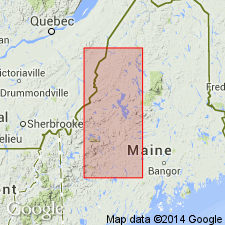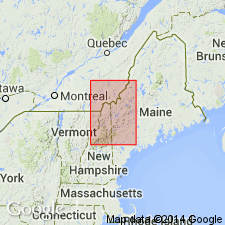
- Usage in publication:
-
- Grenier Ponds Member
- Modifications:
-
- Overview
- Areal extent
- AAPG geologic province:
-
- New England province
Summary:
Grenier Ponds Member of Ironbound Mountain Formation is exposed in extreme northwestern corner of Penobscot Lake and adjacent part of Sandy Bay quads. Rocks in northeastern part of Seboomook Lake quad are also assigned to this member. Best estimate of thickness is 600 m. Unit is composed of massive, light gray weathering, fine- to medium-grained, quartzose lithic wacke and well-cleaved dark gray mudstone slate in approximately equal proportions. Toward the southwest, the graywackes become less prevalent and the slate more dominant. Distinct light-flecked appearance of graywacke caused by slate fragments. Conformably underlies main body of Ironbound Mountain Formation. Ironbound Mountain may span the Silurian-Devonian boundary and range from possibly latest Pridolian to earliest Gedinnian.
Source: GNU records (USGS DDS-6; Reston GNULEX).

- Usage in publication:
-
- Grenier Ponds Grit Member*
- Modifications:
-
- Named
- Dominant lithology:
-
- Grit
- Sandstone
- Slate
- AAPG geologic province:
-
- New England province
Summary:
Grenier Ponds Member of Ironbound Mountain Formation was named by Marvinney (1986, unpub Ph.D dissertation) for exposures of thickly interbedded quartzose, lithic metasandstone, and gray slate near Middle Grenier Pond, Sandy Bay 15-min quad, and Big Grenier Pond, Penobscot Lake 15-min quad, ME. He designated type locality at about 2 km east of Big Grenier Pond, along logging road in small valley lying just southwest of Hill 1915, Penobscot Lake quad. He correlated type Grenier Ponds with extensive exposures of similar rocks in map area, about 35 km to the east, on the opposite side of anticlinorial belt underlain by Frontenac Formation, where arenaceous rocks strongly resemble those of type Grenier Ponds and grade laterally southward into rocks of Frontenac. The unit is here adopted for use on Sherbrooke-Lewiston 100K quad, but is revised as Grenier Ponds Grit Member of Ironbound Mountain Formation (revised) of Seboomook Group (rank raised); revision of name is made to emphasize lithologic character. Minimum thickness is 600 m. Considered equivalent to nearly identical lenses of grit, shown on map as "grit lenses at Halls Stream" within Ironbound Mountain Formation. Felsic volcanic member of Ironbound Mountain Formation also contains abundant grit lenses similar to Grenier Ponds. Age is Early Devonian, which is inferred age of Ironbound Mountain Formation.
Source: GNU records (USGS DDS-6; Reston GNULEX).
For more information, please contact Nancy Stamm, Geologic Names Committee Secretary.
Asterisk (*) indicates published by U.S. Geological Survey authors.
"No current usage" (†) implies that a name has been abandoned or has fallen into disuse. Former usage and, if known, replacement name given in parentheses ( ).
Slash (/) indicates name conflicts with nomenclatural guidelines (CSN, 1933; ACSN, 1961, 1970; NACSN, 1983, 2005, 2021). May be explained within brackets ([ ]).

